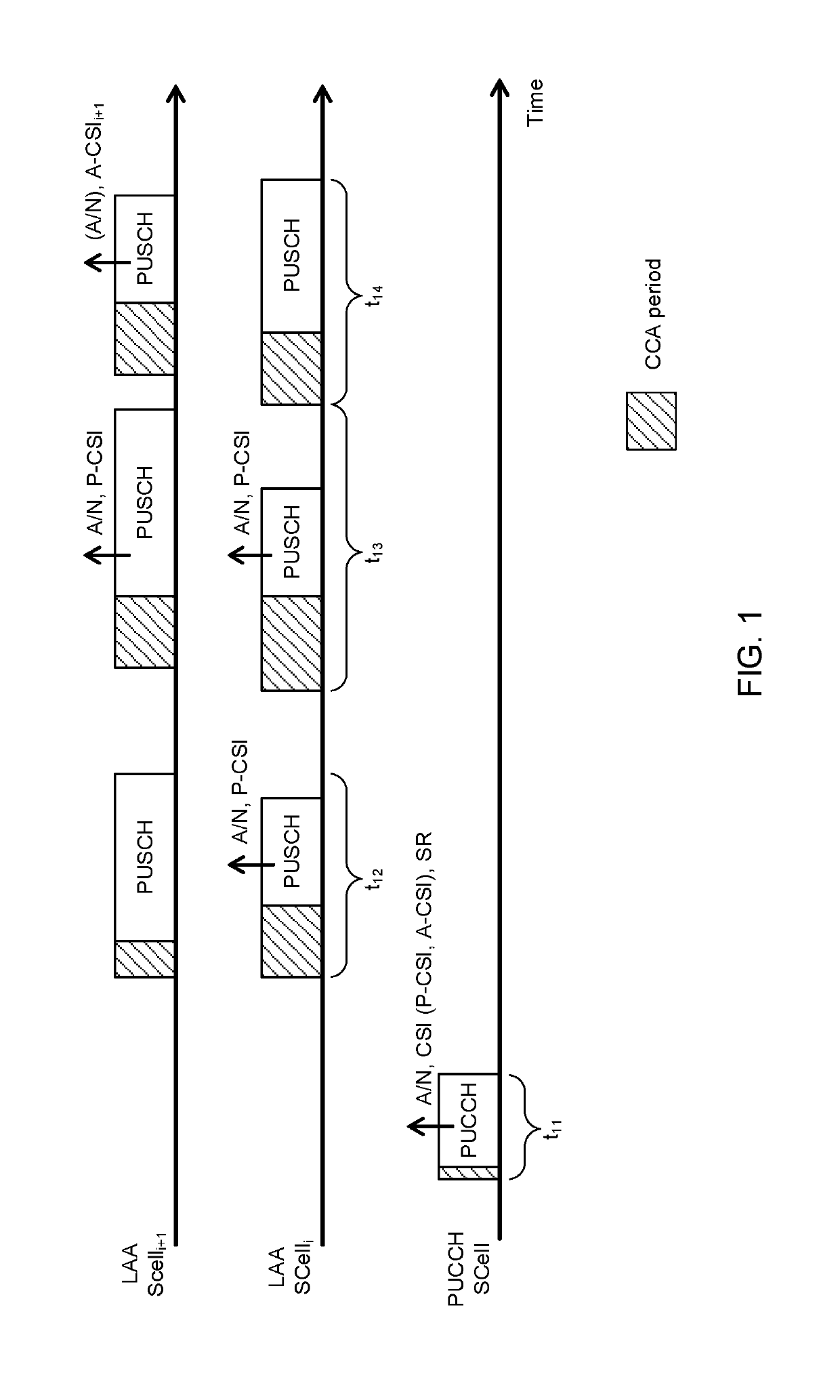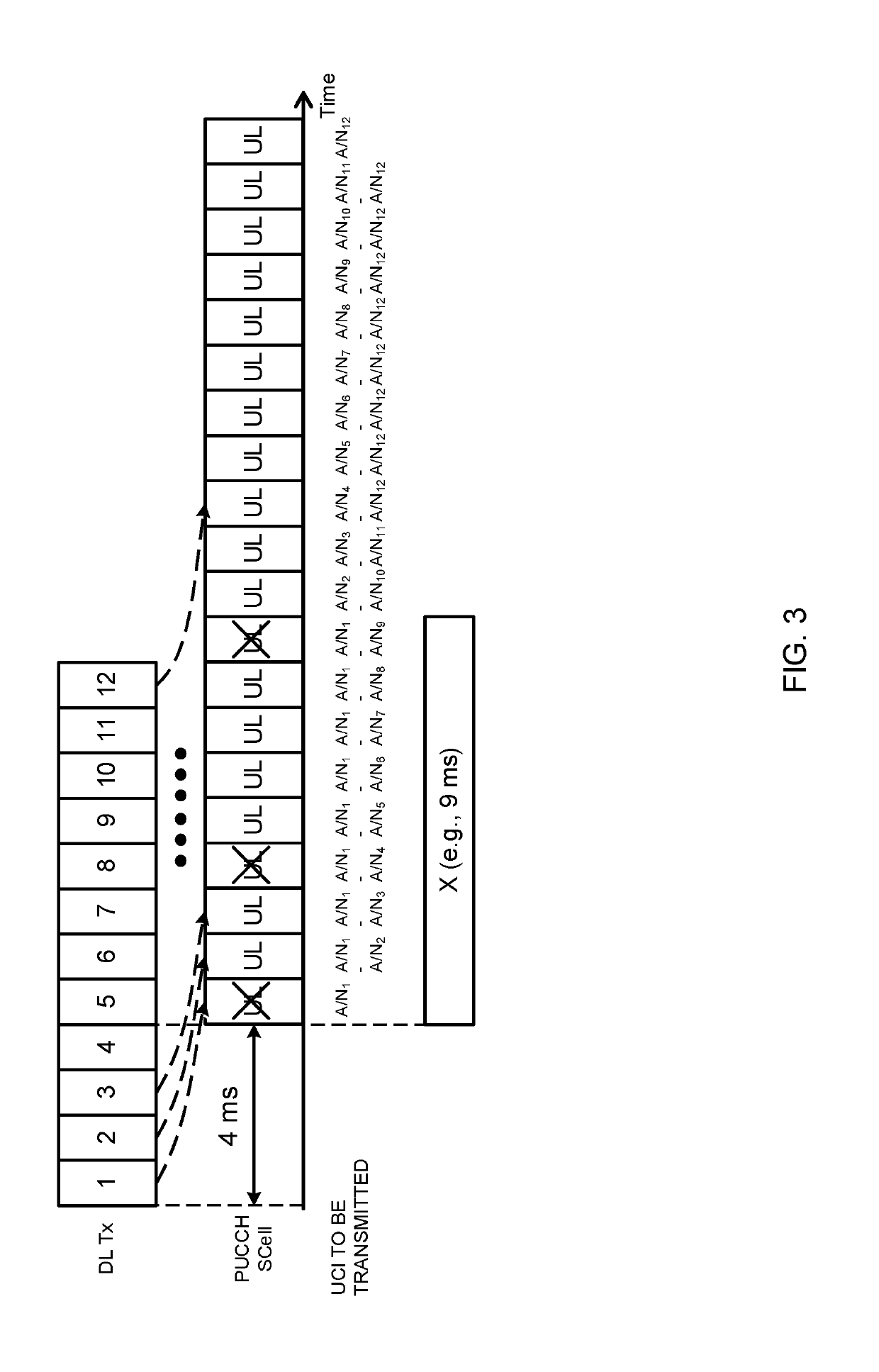User terminal, radio base station and radio communication method
a radio communication method and user terminal technology, applied in the direction of wireless communication, network data management, electrical equipment, etc., can solve the problem of limited spectra of licensed bands, and achieve the effect of adequately transmitting uci
- Summary
- Abstract
- Description
- Claims
- Application Information
AI Technical Summary
Benefits of technology
Problems solved by technology
Method used
Image
Examples
first embodiment
[0067]According to the first embodiment of the present invention, a UE reports information as to whether or not the UE supports transmission in PUCCH format (PF: PUCCH Format) 4 and / or 5 (whether or not to support PF 4 / 5) in LAA SCells, to the network side (for example, eNB), as terminal capability information (UE capability).
[0068]This capability information here may be reported using one or a combination of the following: (1) Existing UE capability information bits (capability bits) to indicate that PF 4 / 5 are supported (these bits may be included and reported in, for example, PhyLayerParameters-v13x0, which is specified as a parameter for LTE Rel. 13); (2) New UE capability information bits to indicate that PF 4 / 5 are supported in LAA SCells (these bits may be included, for example, in PhyLayerParameters-v14x0, which is defined as a parameter for LTE Rel. 14, and reported as UL-LAA-specific information); (3) L-LAA UE capability information, including capability information to ind...
embodiment 2.1
[0078]FIG. 1 is a diagram to explain the UCI transmission operation according to embodiment 2.1. FIG. 1 illustrates three LAA SCells. “PUCCH SCell” is an LAA SCell that is capable of PUCCH transmission (configured as a PUCCH cell). “LAA SCelli” and “LAA SCelli+1” are LAA SCells that cannot perform PUCCH transmission (not configured as PUCCH cells). Assume that the SCell index of LAA SCelli is smaller than that of either LAA SCelli+1 or the PUCCH SCell. Note that application of this embodiment is not limited to the case where a UE uses three LAA SCells.
[0079]In FIG. 1, a UE executes listening in the CCA period before transmitting UL signals in each SCell, and, upon judging that the channel is idle, the UE carries out UL transmission. In addition, periods t11 to t14 illustrated in FIG. 1 are simply exemplary periods for explaining the UCI transmission operation, and the order these periods occur, the length of these periods and so on are not limited.
[0080]At a timing (for example, a T...
embodiment 2.2
[0087]FIG. 2 is a diagram to explain the UCI transmission operation according to embodiment 2.2. FIG. 2 illustrates a similar example to FIG. 1.
[0088]At a timing where at least one of A / N, P-CSI and SR should be transmitted (for example, TTI), the UE transmits the UCI based on the LBT in the PUCCH on the LAA SCell (PUCCH SCell) (illustrated as t21, t23, t24 and t25).
[0089]FIG. 2 illustrates an example in which the UE transmits PUCCH in PF 4 / 5 in LAA SCells, but different PFs may be used as well. Note that at a timing where only one P-CSI is transmitted in PUCCH, the UE may transmit this one P-CSI in PF 4 and / or 5, or transmit this one P-CSI in an existing PF (for example, PF 2).
[0090]At a timing where A-CSI is triggered (A-CSI is transmitted), the UE transmits A-CSI based on LBT using the PUSCH of the triggered cell (exemplified at t22 and t25). For example, at t22, A-CSI (A-CSIi) for LAA SCelli is transmitted in LAA SCelli.
PUM
 Login to View More
Login to View More Abstract
Description
Claims
Application Information
 Login to View More
Login to View More - R&D
- Intellectual Property
- Life Sciences
- Materials
- Tech Scout
- Unparalleled Data Quality
- Higher Quality Content
- 60% Fewer Hallucinations
Browse by: Latest US Patents, China's latest patents, Technical Efficacy Thesaurus, Application Domain, Technology Topic, Popular Technical Reports.
© 2025 PatSnap. All rights reserved.Legal|Privacy policy|Modern Slavery Act Transparency Statement|Sitemap|About US| Contact US: help@patsnap.com



